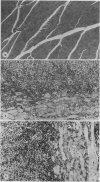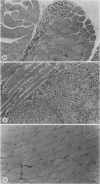Abstract
The paralelism between the capacity of various agents to elicit chronic inflammatory responses in vivo and to induce the selective release of lysosomal enzymes from cultures of mouse peritoneal macrophages in vitro is discussed. Zymosan elicits an intense inflammatory response when injected i.m. in mice. Chrysotile asbestos produces a response of a similar nature and intensity as is seen with zymosan, while injections of acid-leached asbestos and polystyrene latex are not followed by inflammation. It is also shown that zymosan and asbestos induce a dose-dependent increase in the total enzyme activity of an inflamed muscle. On the other hand latex and acid-leached asbestos caused no significant increases in lysosomal enzyme levels. Agents eliciting inflammatory responses, such as zymosan and chrysotile asbestos induce a selective release of acid hydrolases from cultured macrophages; in contrast agents lacking the capacity to induce inflammation, such as latex and acid-leached chrysotile asbestos, do not induce the release of lysosomal enzymes from cultured macrophages.
Full text
PDF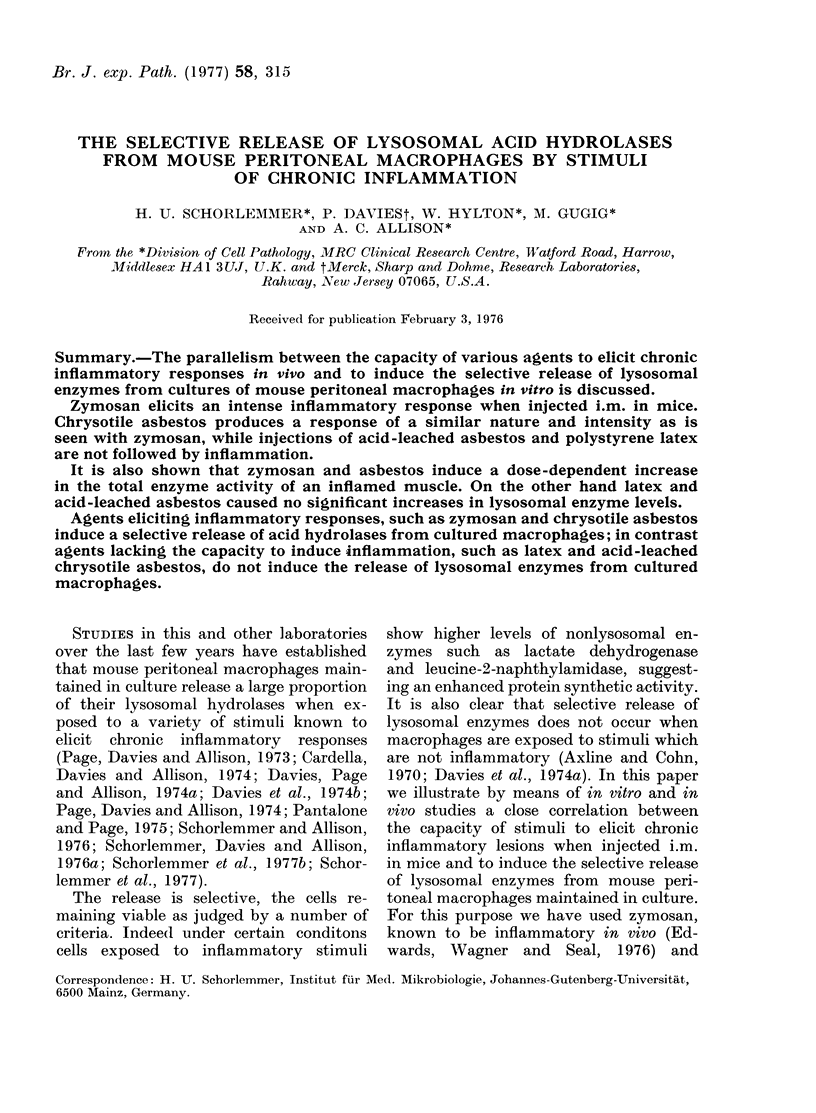
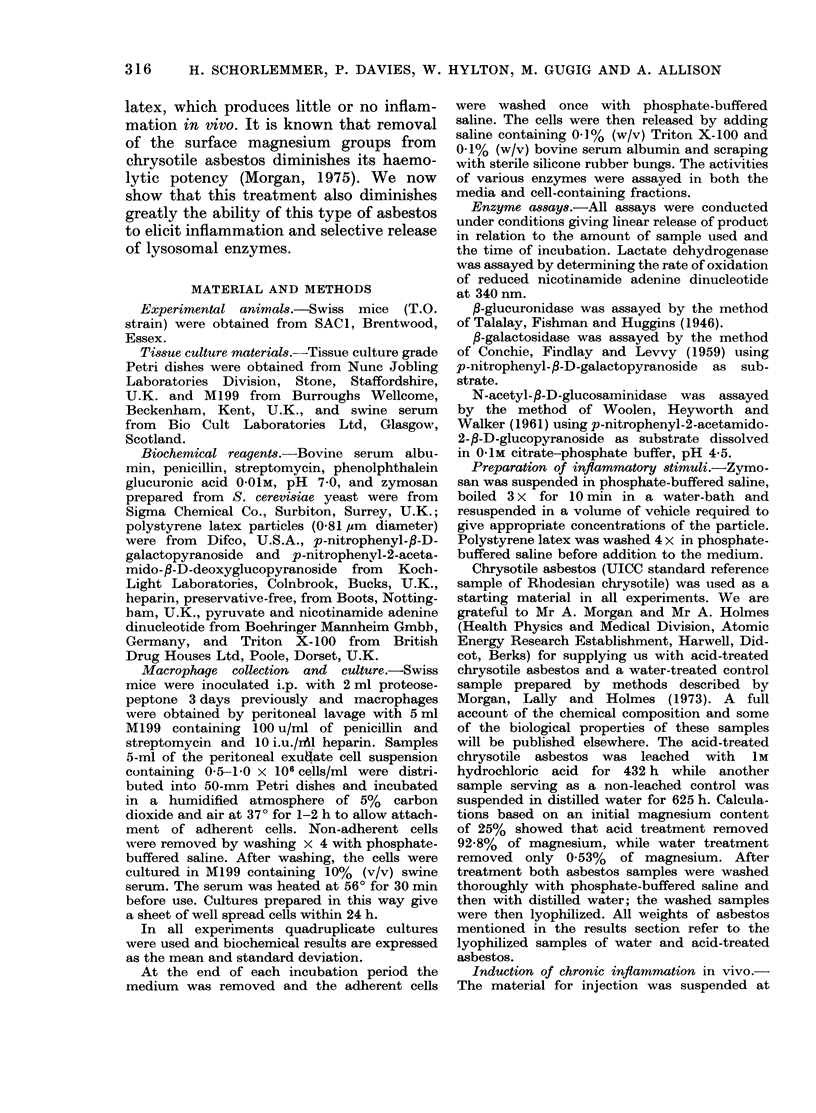
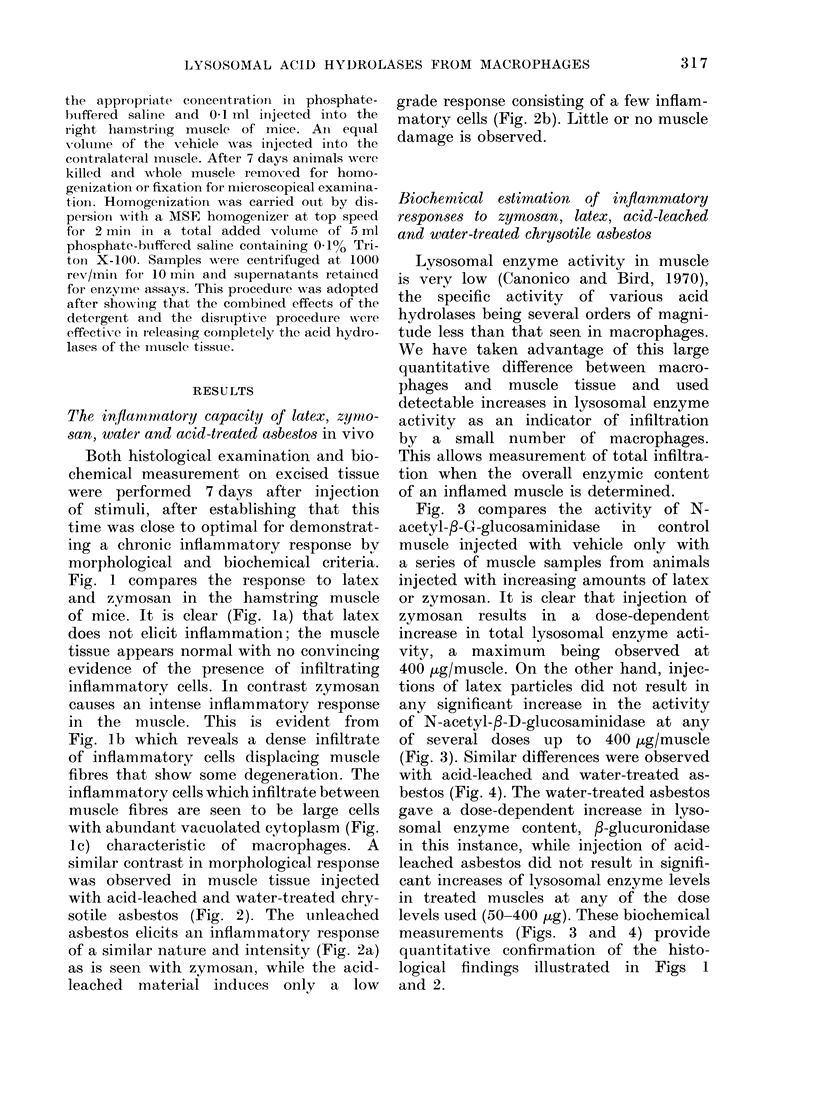
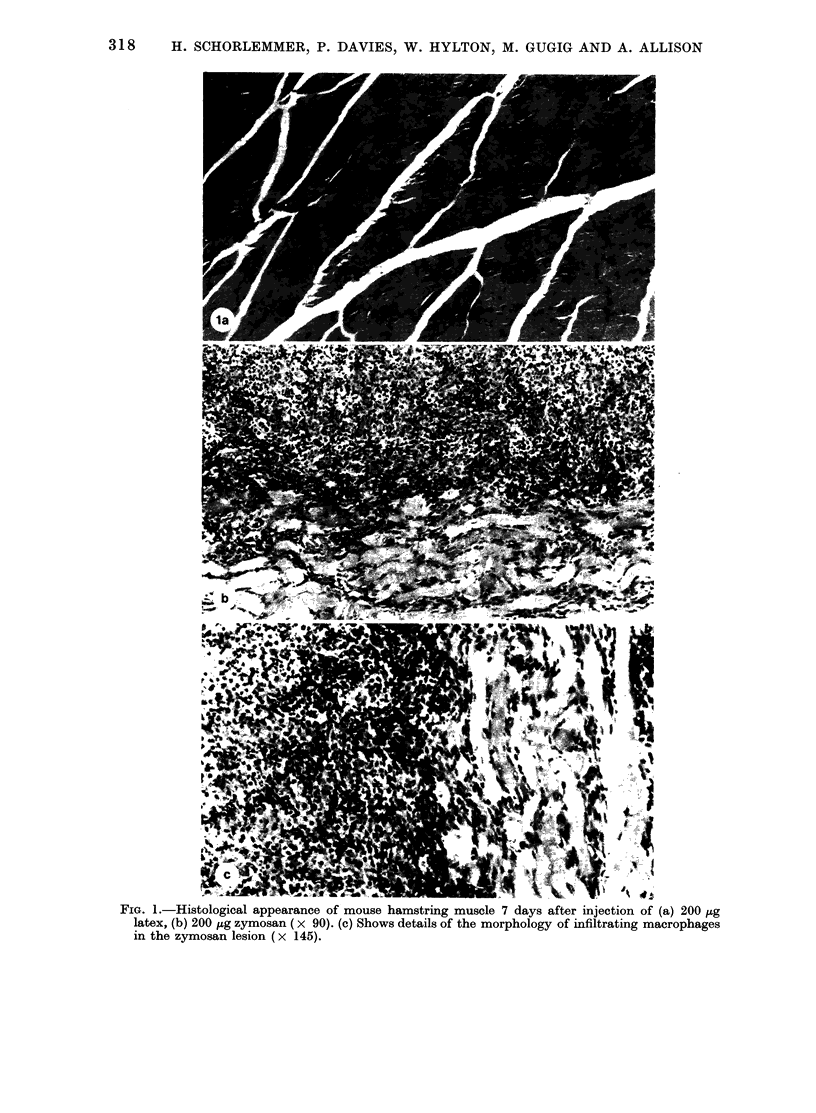
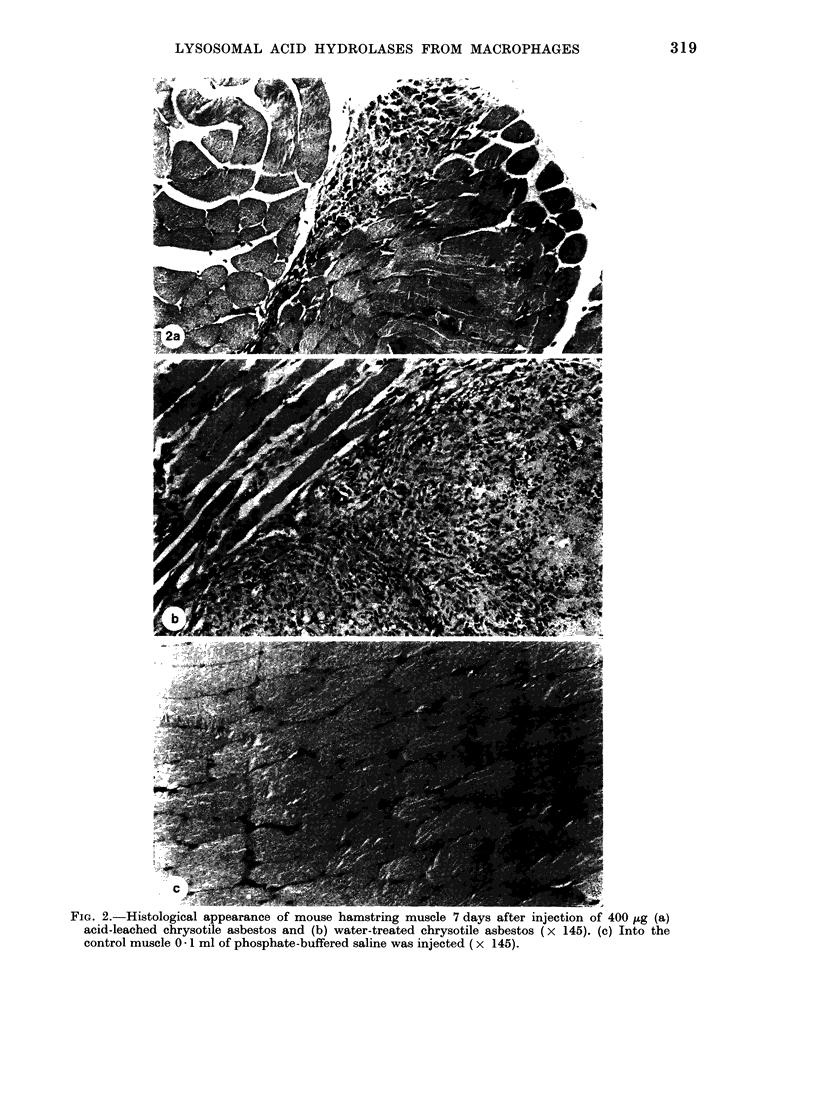
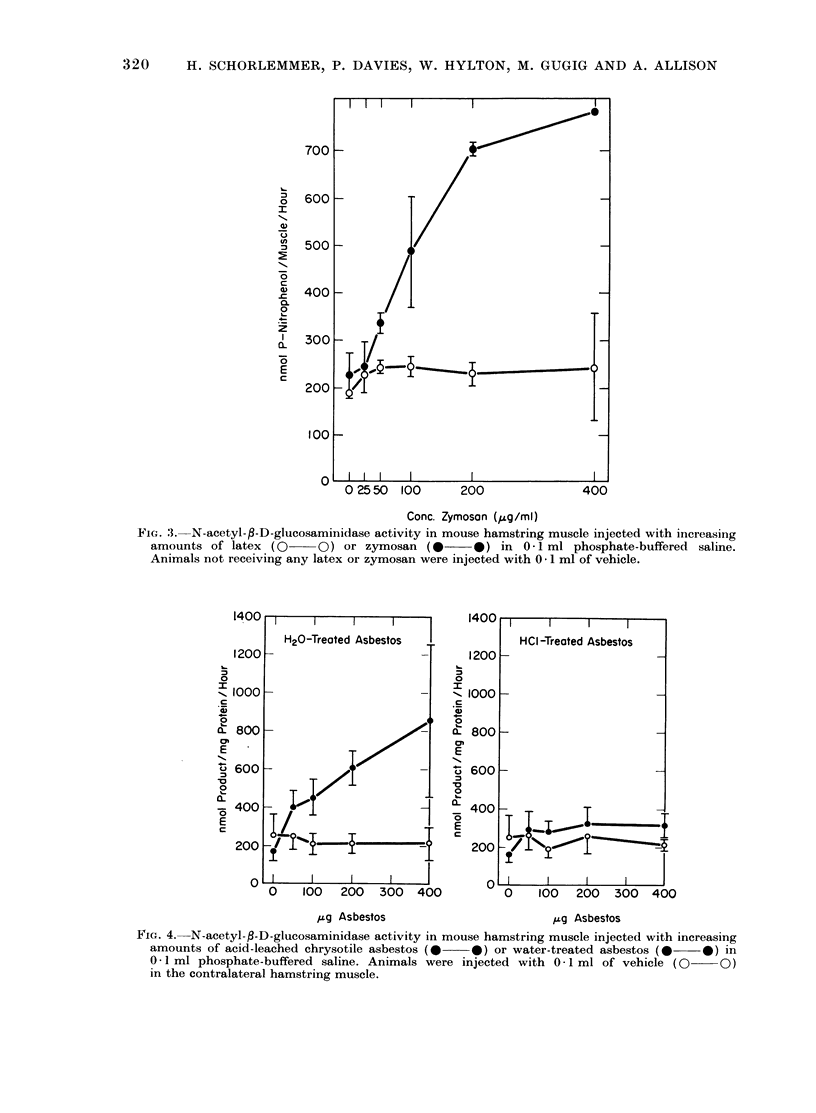
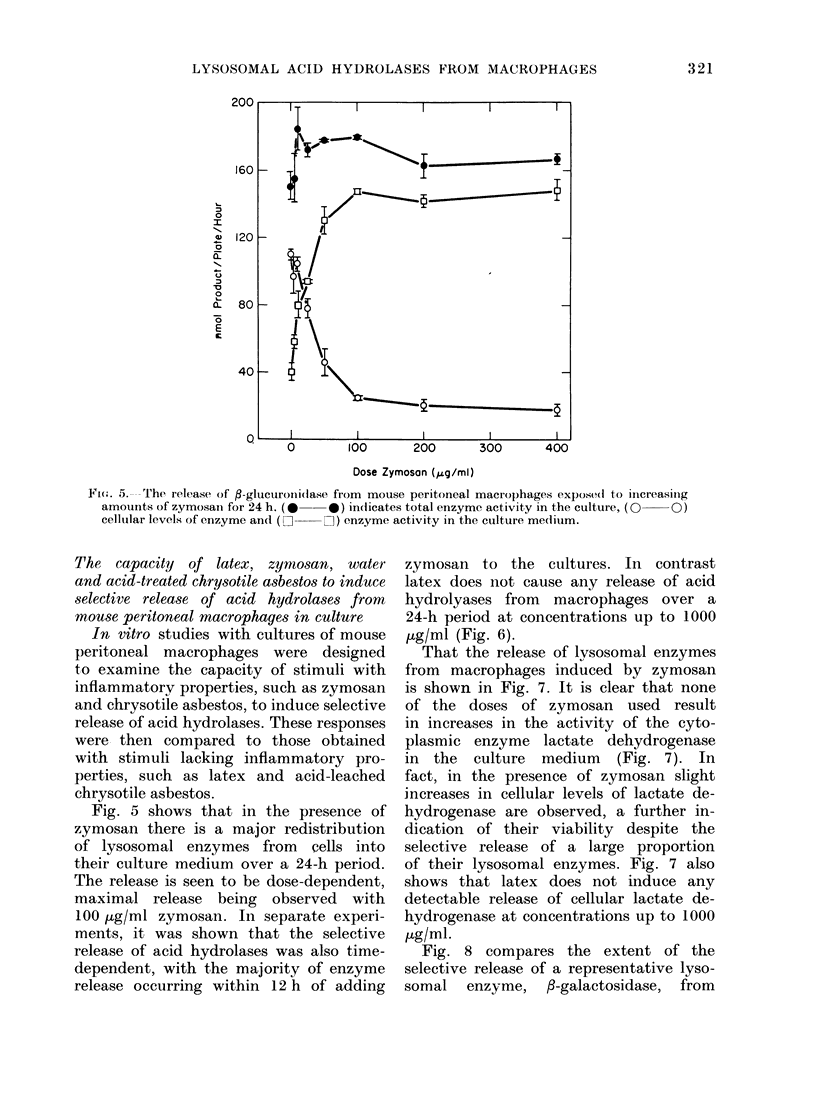
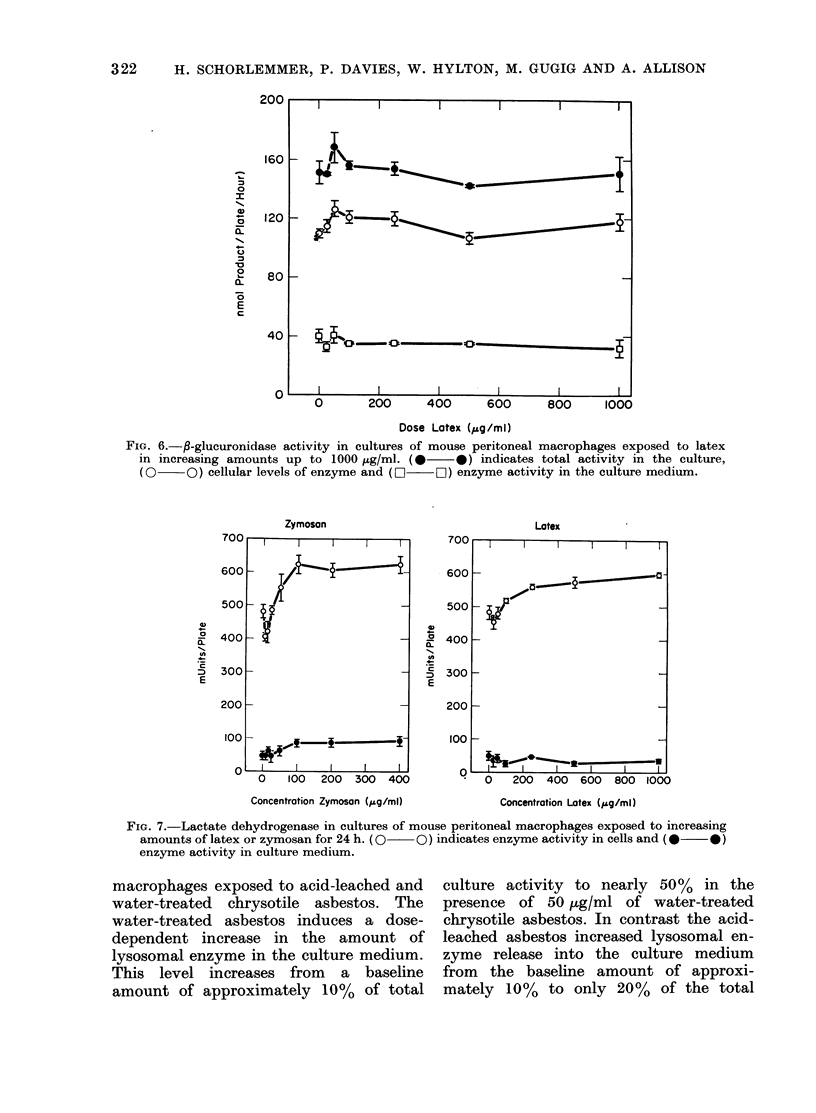
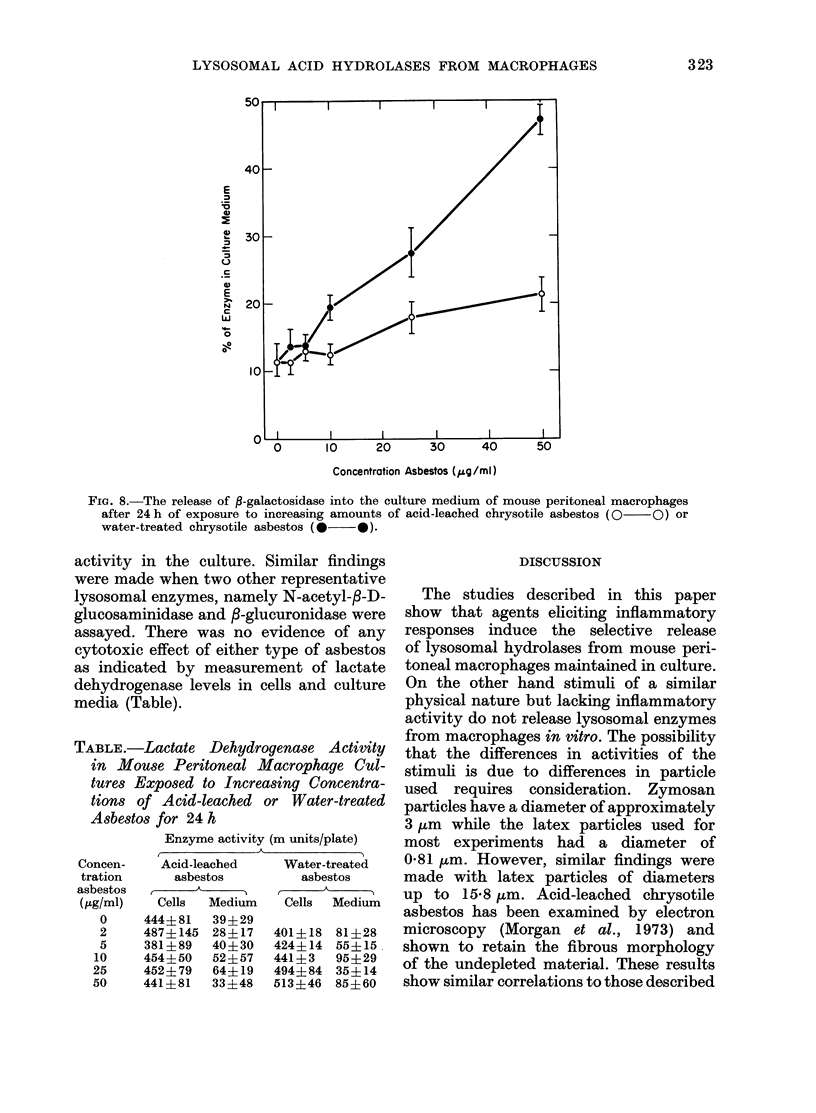
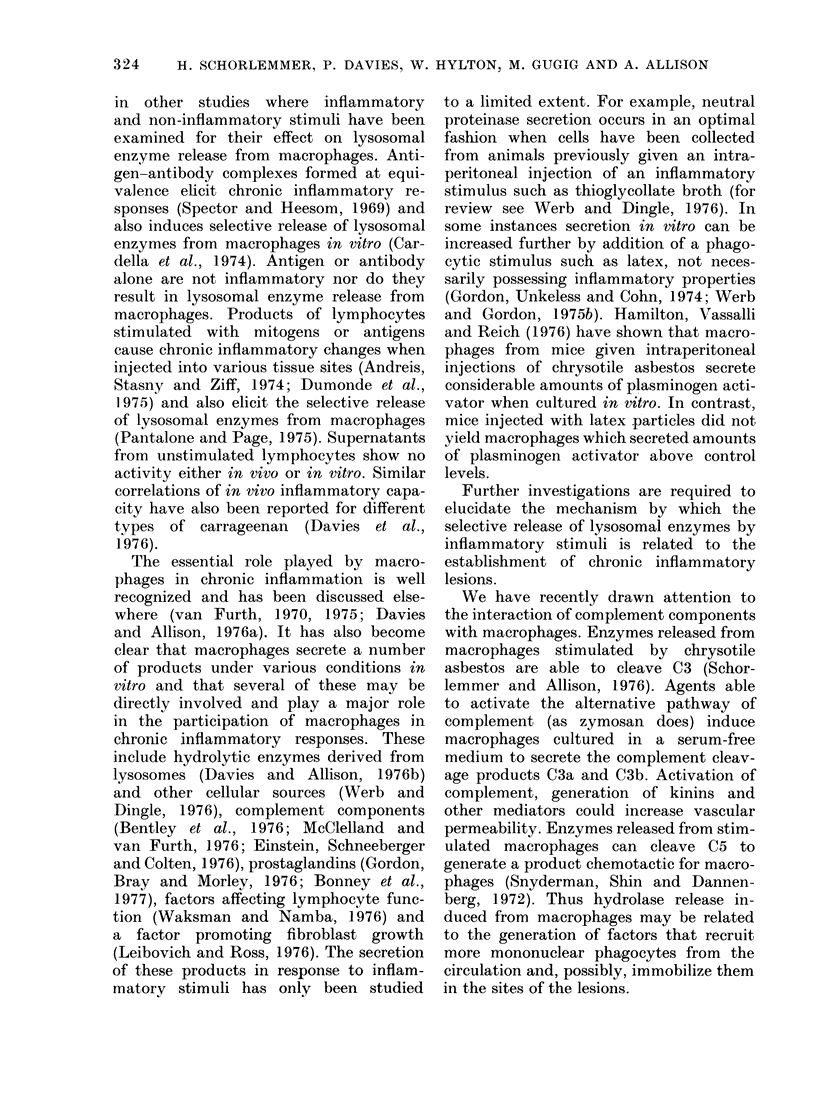
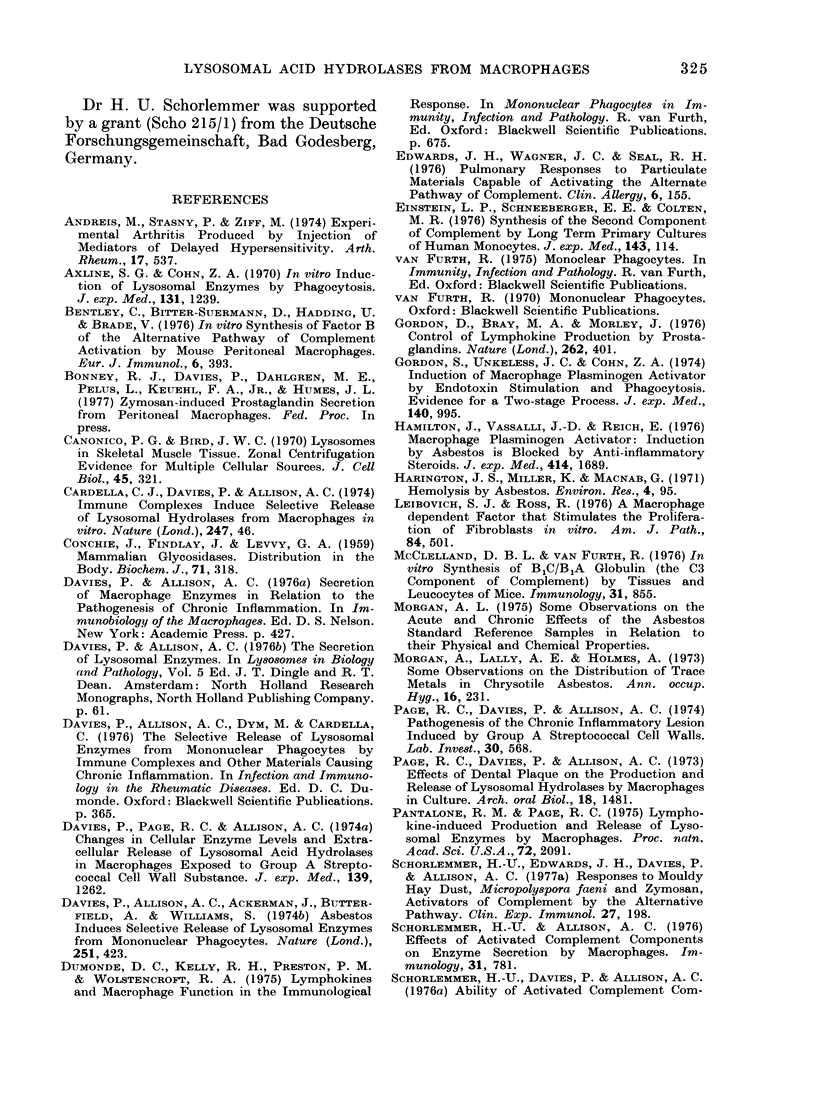
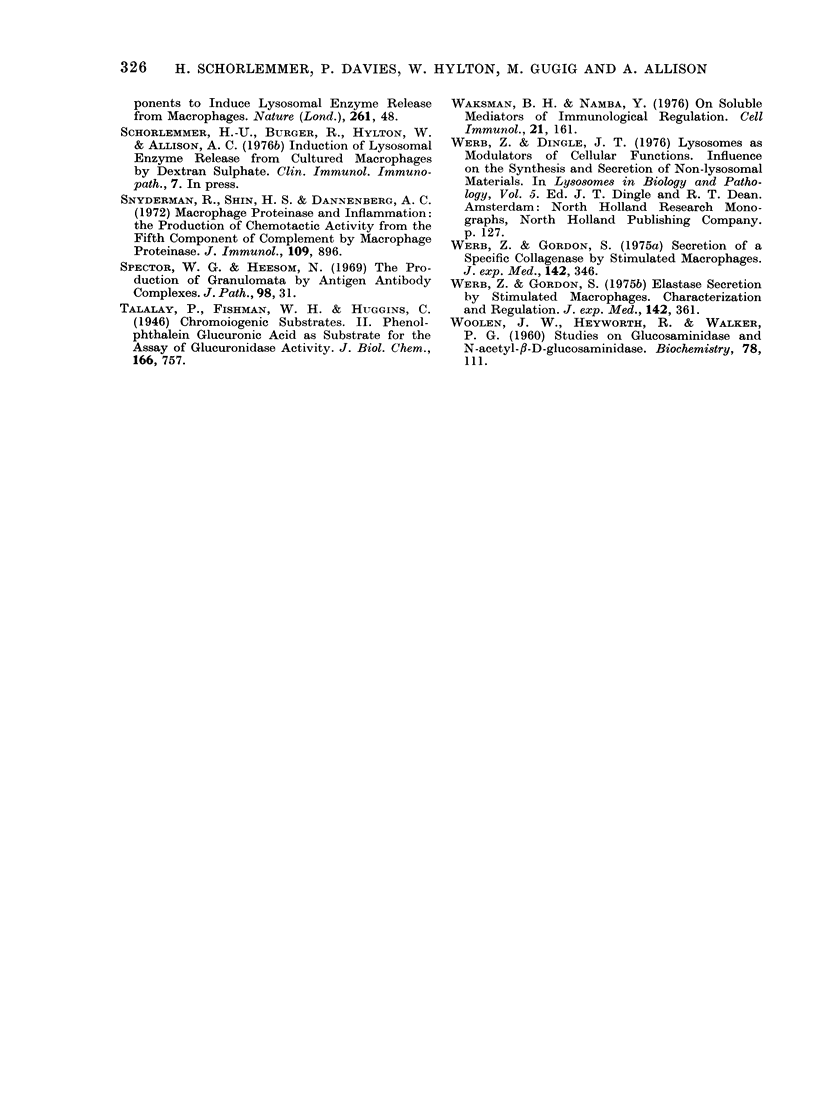
Images in this article
Selected References
These references are in PubMed. This may not be the complete list of references from this article.
- Andreis M., Stastny P., Ziff M. Experimental arthritis produced by injection of mediators of delayed hypersensitivity. Arthritis Rheum. 1974 Sep-Oct;17(5):537–551. doi: 10.1002/art.1780170508. [DOI] [PubMed] [Google Scholar]
- Axline S. G., Cohn Z. A. In vitro induction of lysosomal enzymes by phagocytosis. J Exp Med. 1970 Jun 1;131(6):1239–1260. doi: 10.1084/jem.131.6.1239. [DOI] [PMC free article] [PubMed] [Google Scholar]
- Bentley C., Bitter-Suermann D., Hadding U., Brade V. In vitro synthesis of factor B of the alternative pathway of complement activation by mouse peritoneal macrophages. Eur J Immunol. 1976 Jun;6(6):393–398. doi: 10.1002/eji.1830060604. [DOI] [PubMed] [Google Scholar]
- CONCHIE J., FINDLAY J., LEVVY G. A. Mammalian glycosidases; distribution in the body. Biochem J. 1959 Feb;71(2):318–325. doi: 10.1042/bj0710318. [DOI] [PMC free article] [PubMed] [Google Scholar]
- Canonico P. G., Bird J. W. Lysosomes in skeletal muscle tissue. Zonal centrifugation evidence for multiple cellular sources. J Cell Biol. 1970 May;45(2):321–333. doi: 10.1083/jcb.45.2.321. [DOI] [PMC free article] [PubMed] [Google Scholar]
- Cardella C. J., Davies P., Allison A. C. Immune complexes induce selective release of lysosomal hydrolases from macrophages. Nature. 1974 Jan 4;247(5435):46–48. doi: 10.1038/247046a0. [DOI] [PubMed] [Google Scholar]
- Davies P., Allison A. C., Ackerman J., Butterfield A., Williams S. Asbestos induces selective release of lysosomal enzymes from mononuclear phagocytes. Nature. 1974 Oct 4;251(5474):423–425. doi: 10.1038/251423a0. [DOI] [PubMed] [Google Scholar]
- Davies P., Page R. C., Allison A. C. Changes in cellular enzyme levels and extracellular release of lysosomal acid hydrolases in macrophages exposed to group A streptococcal cell wall substance. J Exp Med. 1974 May 1;139(5):1262–1282. doi: 10.1084/jem.139.5.1262. [DOI] [PMC free article] [PubMed] [Google Scholar]
- Edwards J. H., Wagner J. C., Seal R. M. Pulmonary responses to particulate materials capable of activating the alternative pathway of complement. Clin Allergy. 1976 Mar;6(2):155–164. doi: 10.1111/j.1365-2222.1976.tb01893.x. [DOI] [PubMed] [Google Scholar]
- Einstein L. P., Schneeberger E. E., Colten H. R. Synthesis of the second component of complement by long-term primary cultures of human monocytes. J Exp Med. 1976 Jan 1;143(1):114–126. doi: 10.1084/jem.143.1.114. [DOI] [PMC free article] [PubMed] [Google Scholar]
- Gordon D., Bray M. A., Morley J. Control of lymphokine secretion by prostaglandins. Nature. 1976 Jul 29;262(5567):401–402. doi: 10.1038/262401a0. [DOI] [PubMed] [Google Scholar]
- Gordon S., Unkeless J. C., Cohn Z. A. Induction of macrophage plasminogen activator by endotoxin stimulation and phagocytosis: evidence for a two-stage process. J Exp Med. 1974 Oct 1;140(4):995–1010. doi: 10.1084/jem.140.4.995. [DOI] [PMC free article] [PubMed] [Google Scholar]
- Hamilton J., Vassalli J. D., Reich E. Macrophage plasminogen activator: induction by asbestos is blocked by anti-inflammatory steroids. J Exp Med. 1976 Dec 1;144(6):1689–1694. doi: 10.1084/jem.144.6.1689. [DOI] [PMC free article] [PubMed] [Google Scholar]
- Leibovich S. J., Ross R. A macrophage-dependent factor that stimulates the proliferation of fibroblasts in vitro. Am J Pathol. 1976 Sep;84(3):501–514. [PMC free article] [PubMed] [Google Scholar]
- McClelland D. B., Furth R. V. In vitro synthesis of beta1C/beta1A globulin (the C3 component of complement) by tissues and leucocytes of mice. Immunology. 1976 Dec;31(6):855–861. [PMC free article] [PubMed] [Google Scholar]
- Morgan A., Lally A. E., Holmes A. Some observations on the distribution of trace metals in chrysotile asbestos. Ann Occup Hyg. 1973 Nov;16(3):231–240. doi: 10.1093/annhyg/16.3.231. [DOI] [PubMed] [Google Scholar]
- Page R. C., Davies P., Allison A. C. Effects of dental plaque on the production and release of lysosomal hydrolases by macrophages in culture. Arch Oral Biol. 1973 Dec;18(12):1481–1495. doi: 10.1016/0003-9969(73)90124-6. [DOI] [PubMed] [Google Scholar]
- Page R. C., Davies P., Allison A. C. Pathogenesis of the chronic inflammatory lesion induced by group A streptococcal cell walls. Lab Invest. 1974 May;30(5):568–581. [PubMed] [Google Scholar]
- Pantalone R. M., Page R. C. Lymphokine-induced production and release of lysosomal enzymes by macrophages. Proc Natl Acad Sci U S A. 1975 Jun;72(6):2091–2094. doi: 10.1073/pnas.72.6.2091. [DOI] [PMC free article] [PubMed] [Google Scholar]
- Schorlemmer H. U., Allison A. C. Effects of activated complement components on enzyme secretion by macrophages. Immunology. 1976 Nov;31(5):781–788. [PMC free article] [PubMed] [Google Scholar]
- Schorlemmer H. U., Davies P., Allison A. C. Ability of activated complement components to induce lysosomal enzyme release from macrophages. Nature. 1976 May 6;261(5555):48–49. doi: 10.1038/261048a0. [DOI] [PubMed] [Google Scholar]
- Schorlemmer H. U., Edwards J. H., Davies P., Allison A. C. Macrophage responses to mouldy hay dust, Micropolyspora faeni and zymosan, activators of complement by the alternative pathway. Clin Exp Immunol. 1977 Feb;27(2):198–207. [PMC free article] [PubMed] [Google Scholar]
- Snyderman R., Shin H., Dannenberg A. M., Jr Macrophage proteinase and inflammation: the production of chemotactic activity from the fifth complement by macrophage proteinase. J Immunol. 1972 Oct;109(4):896–898. [PubMed] [Google Scholar]
- Spector W. G., Heesom N. The production of granulomata by antigen-antibody complexes. J Pathol. 1969 May;98(1):31–39. doi: 10.1002/path.1710980105. [DOI] [PubMed] [Google Scholar]
- Waksman B. H., Namba Y. On soluble mediators of immunologic regulation. Cell Immunol. 1976 Jan;21(1):161–176. doi: 10.1016/0008-8749(76)90337-3. [DOI] [PubMed] [Google Scholar]
- Werb Z., Gordon S. Elastase secretion by stimulated macrophages. Characterization and regulation. J Exp Med. 1975 Aug 1;142(2):361–377. doi: 10.1084/jem.142.2.361. [DOI] [PMC free article] [PubMed] [Google Scholar]
- Werb Z., Gordon S. Secretion of a specific collagenase by stimulated macrophages. J Exp Med. 1975 Aug 1;142(2):346–360. doi: 10.1084/jem.142.2.346. [DOI] [PMC free article] [PubMed] [Google Scholar]



